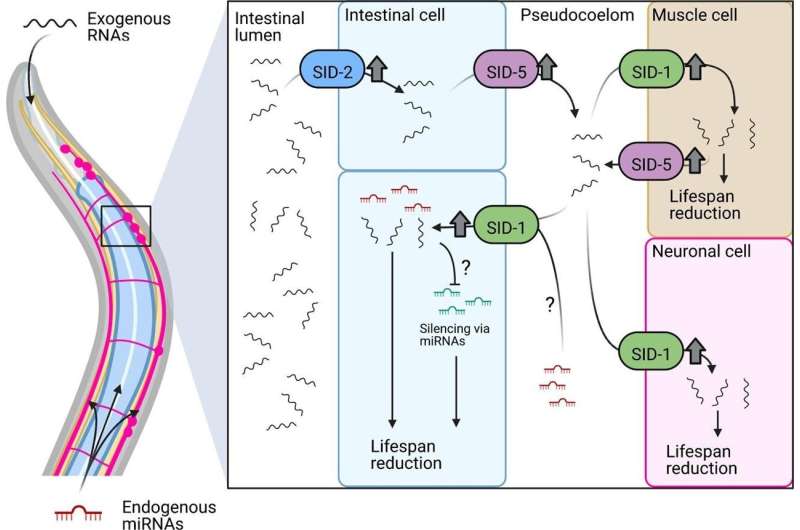This article has been reviewed according to Science X's editorial process and policies. Editors have highlighted the following attributes while ensuring the content's credibility:
fact-checked
trusted source
proofread
Important molecular pathway for control of aging discovered

One of the ways cells in different kinds of tissue communicate is by exchanging RNA molecules. In experiments with roundworms of the species Caenorhabditis elegans, researchers at the State University of Campinas (UNICAMP) in Brazil found that when this communication pathway is dysregulated, the organism's lifespan is shortened.
An article on the study is published in the journal Gene. The findings contribute to a better understanding of the aging process and associated diseases.
"Previous research showed that some types of RNA can be transferred from one cell to another, mediating intertissue communication, of the kind that occurs with proteins and metabolites, for example. This is considered a mechanism for signaling between organs or neighboring cells. It's part [of the physiopathology] of several diseases and of the organism's normal functioning," said Marcelo Mori, corresponding author of the article and a professor at the Institute of Biology (IB-UNICAMP).
"What wasn't clear, and we've now succeeded in proving, is that changes in the pattern of this 'conversation' between RNA molecules can affect aging."
"This communication mechanism has to be well adjusted to give the organism an adequate lifespan. In the study, we found that if any tissue happens to increase its capacity to absorb some types of RNA from the extracellular medium, this ends up having an impact on the organism's lifespan," Mori said.
The researchers demonstrated that the reduction in lifespan was due not only to the disruption of RNA-based communication between tissues in the same organism, he added, but also to an increase in the capacity for RNA uptake from the environment—bacteria in microbiota, for example.
As they explain in the article, "Our data support the notion that systemic RNA signaling must be tightly regulated, and unbalancing that process provokes a reduction in lifespan. We termed this phenomenon Intercellular/Extracellular Systemic RNA imbalance (InExS)."
Breaking the rules
Mori explained that the decision to research the intercellular RNA transport mechanism was inspired by the discovery of RNA interference, for which American scientists Andrew Fire and Craig Mello won the 2006 Nobel Prize in Physiology and Medicine. They injected double-stranded RNA into C. elegans to "silence" genes with great precision.
"They found that the silencing mechanism affected genes in other tissues as well as the tissue involved and that it was transmitted to following generations," he said.
The discovery of RNA interference elucidated the mechanisms underlying RNA transfer between cells in an organism and between the organism and the environment. It also relativized a central dogma of molecular biology. Until then, the information embodied by the genetic code was believed to flow only from DNA to RNA and from there to proteins, but the work of Fire and Craig revealed that double-stranded RNA can block this flow.
Messenger RNA is destroyed by RNA interference, which silences specific genes without altering the DNA sequence, showing that RNA can also perform a regulatory function in the genome. Although the human genome comprises some 30,000 genes, only a few are used in each cell to synthesize proteins. A large proportion play a regulatory role, influencing the expression of other genes.
Balance is all
"We wanted to understand how this process could interfere with important physiological functions linked to aging. In C. elegans, RNA transfer between cells involves what are known as systemic RNA interference defective (SID) genes [responsible for different stages in RNA absorption and export]."
"We observed that a gene expression pattern associated with this pathway in specific tissues changed during aging. The messenger RNA that encodes the protein SID-1 [fundamental to cellular uptake of RNA], for example, increased in some tissues and decreased in others," Mori said.
To find out more about the role of RNA in intertissue signaling, the researchers conducted experiments in which they manipulated the expression of the protein SID-1 in specific tissues of C. elegans, such as neuronal, intestinal, and muscle cells, in order to change its function.
"We found mutants without the SID-1 function to be as healthy as wild-type worms, whereas overexpression of SID-1 in the gut, muscles, or neurons shortened the lifespan of the worms concerned. We also found that a lifespan reduction correlated with overexpression of other proteins in the RNA transport pathway, such as SID-2 and SID-5," he said.
The dysregulation may reside in the distribution of RNA to tissue. "To dysregulate RNA distribution in the worms, we increased SID-1 expression in specific tissues [gut, muscles, and neurons] and found that channeling it to a specific organ led to a lifespan reduction," he said.
"We also showed that this imbalance in RNA transfer led to loss of function in the pathway that produces microRNAs [small pieces of non-coding RNA with a regulatory function]. It's as if the larger number of RNAs transported to these tissues created a kind of competition in which the production of microRNAs was the loser. Previous research had already shown that loss of function in microRNA production led to a reduction of lifespan."
The UNICAMP group also investigated exogenous RNA transfer (between the outside environment and the organism). As in the previous experiments, a reduction of lifespan correlated with overexpression of SID-2, which mediates RNA uptake from the gut, and with excessive RNA production by bacteria on which the worms feed and which end up in its gut microbiota.
"We believe the worms may use exogenous RNA to monitor microorganisms in the environment, but negative effects may ensue when excessive amounts are absorbed by their tissue," Mori said. "When we forced bacteria in the laboratory to express more double-stranded RNA, the worms' lifespan decreased. Excessive RNA transfer interferes with homeostasis and endogenous RNA production, accelerating the aging process."
More information: Henrique Camara et al, Tissue-specific overexpression of systemic RNA interference components limits lifespan in C. elegans, Gene (2023). DOI: 10.1016/j.gene.2023.148014
Provided by FAPESP





















